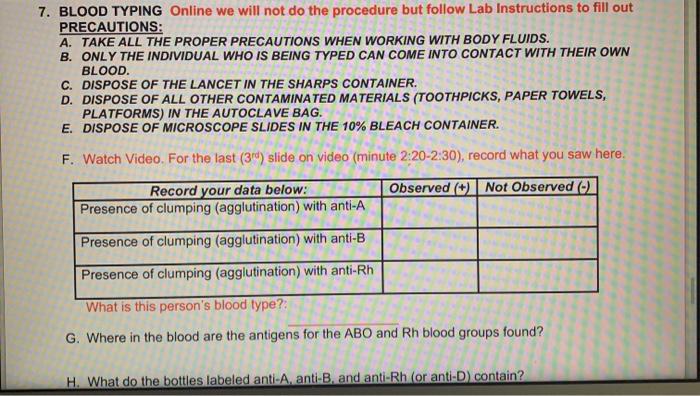
7. BLOOD TYPING Online we will not do the procedure but follow Lab Instructions to fill out PRECAUTIONS: A. TAKE ALL THE PROPER PRECAUTIONS WHEN WORKING WITH BODY FLUIDS. B. ONLY THE INDIVIDUAL WHO IS BEING TYPED CAN COME INTO CONTACT WITH THEIR OWN BLOOD C. DISPOSE OF THE LANCET IN THE SHARPS CONTAINER. D. DISPOSE OF ALL OTHER CONTAMINATED MATERIALS (TOOTHPICKS, PAPER TOWELS, PLATFORMS) IN THE AUTOCLAVE BAG. E. DISPOSE OF MICROSCOPE SLIDES IN THE 10% BLEACH CONTAINER. F. Watch Video. For the last (3rd) slide on video (minute 2:20-2:30), record what you saw here. Observed (0) Not Observed (6) Record your data below: Presence of clumping (agglutination) with anti-A Presence of clumping (agglutination) with anti-B Presence of clumping (agglutination) with anti-Rh What is this person's blood type?: G. Where in the blood are the antigens for the ABO and Rh blood groups found? H. What do the bottles labeled anti-A, anti-B, and anti-Rh (or anti-D) contain?
1. What physically happens when a blood group antigen and a blood group antibody interact?
J. What blood group antigen is present K. What blood group antibody is when you have these blood types?: present for these blood types?: Blood type Which Antigen is present? Blood type Which Antibody is present? Where are they found? Where are they found? A A B B AB AB Rh Rh+ L. Can a person genetically have matching antigens and antibodies for the same blood group? Why or why not?
M. What percentage of the U.S. population has each of the following blood types? BLOOD TYPE % of U.S. Population White Black Asian A AB O Rh+ Rh-
没有找到相关结果